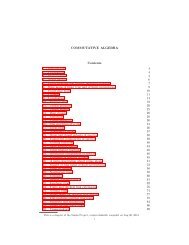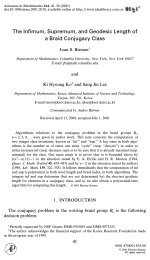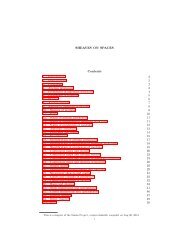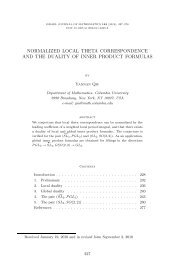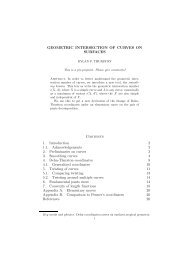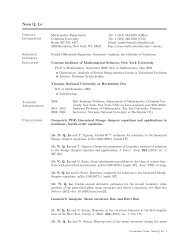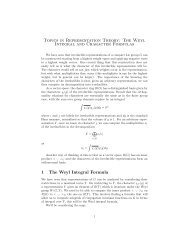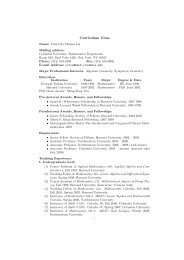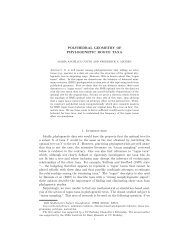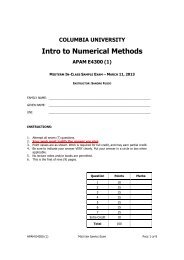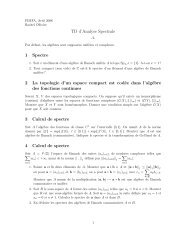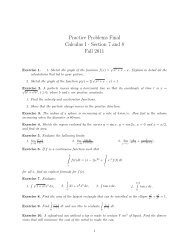INJECTIVES Contents 1. Introduction 1 2. Modules ... - Stacks Project
INJECTIVES Contents 1. Introduction 1 2. Modules ... - Stacks Project
INJECTIVES Contents 1. Introduction 1 2. Modules ... - Stacks Project
You also want an ePaper? Increase the reach of your titles
YUMPU automatically turns print PDFs into web optimized ePapers that Google loves.
10 <strong>INJECTIVES</strong><br />
find F ′ , let X be an object of C such that the inclusion F(X) ⊂ G(X) is strict.<br />
Pick s ∈ G(X), s ∈ F(X). Let ψ : Z #<br />
X → G be the morphism corresponding to the<br />
section s via (8.<strong>2.</strong>1). Set S = ψ−1 (F). By assumption the morphism<br />
S ψ −→ F ϕ −→ J<br />
can be extended to a morphism ϕ ′ : Z #<br />
X → J . Note that ϕ′ annihilates the kernel<br />
of ψ (as this is true for ϕ). Thus ϕ ′ gives rise to a morphism ϕ ′′ : Im(ψ) → J<br />
which agrees with ϕ on the intersection F ∩ Im(ψ) by construction. Thus ϕ and ϕ ′′<br />
glue to give an extension of ϕ to the strictly bigger subsheaf F ′ = F + Im(ψ). <br />
Theorem 8.4. The category of sheaves of abelian groups on a site has enough injectives.<br />
In fact there exists a functorial injective embedding, see Homology, Definition<br />
20.5.<br />
Proof. Let Gi, i ∈ I be a set of abelian sheaves such that every subsheaf of every<br />
Z #<br />
X occurs as one of the Gi. Apply Lemma 8.2 to this collection to get an ordinal β.<br />
We claim that for any sheaf of abelian groups F the map F → Jβ(F) is an injection<br />
of F into an injective. Note that by construction the assingment F ↦→ F → Jβ(F) <br />
is indeed functorial.<br />
The proof of the claim comes from the fact that by Lemma 8.3 it suffices to extend<br />
any morphism γ : G → Jβ(F) from a subsheaf G of some Z #<br />
X to all of Z#<br />
X . Then by<br />
Lemma 8.2 the map γ lifts into Jα(F) for some α < β. Finally, we apply Lemma<br />
8.1 to get the desired extension of γ to a morphism into Jα+1(F) → Jβ(F). <br />
9. <strong>Modules</strong> on a ringed site<br />
Let C be a site. Let O be a sheaf of rings on C. By analogy with More on Algebra,<br />
Section 39 let us try to prove that there are enough injective O-modules. First of<br />
all, we pick an injective embedding<br />
<br />
U,I jU!OU /I −→ J<br />
where J is an injective abelian sheaf (which exists by the previous section). Here<br />
the direct sum is over all objects U of C and over all O-submodules I ⊂ jU!OU .<br />
Please see <strong>Modules</strong> on Sites, Section 19 to read about the functors restriction and<br />
extension by 0 for the localization functor jU : C/U → C.<br />
For any sheaf of O-modules F denote<br />
F ∨ = Hom(F, J )<br />
with its natural O-module structure. Insert here future reference to internal hom.<br />
We will also need a canonical flat resolution of a sheaf of O-modules. This we can<br />
do as follows: For any O-module F we denote<br />
F (F) = <br />
U∈Ob(C),s∈F(U) jU!OU .<br />
This is a flat sheaf of O-modules which comes equipped with a canonical surjection<br />
F (F) → F, see <strong>Modules</strong> on Sites, Lemma 28.6. Moreover the construction F ↦→<br />
F (F) is functorial in F.<br />
Lemma 9.<strong>1.</strong> The functor F ↦→ F ∨ is exact.<br />
Proof. This because J is an injective abelian sheaf.



